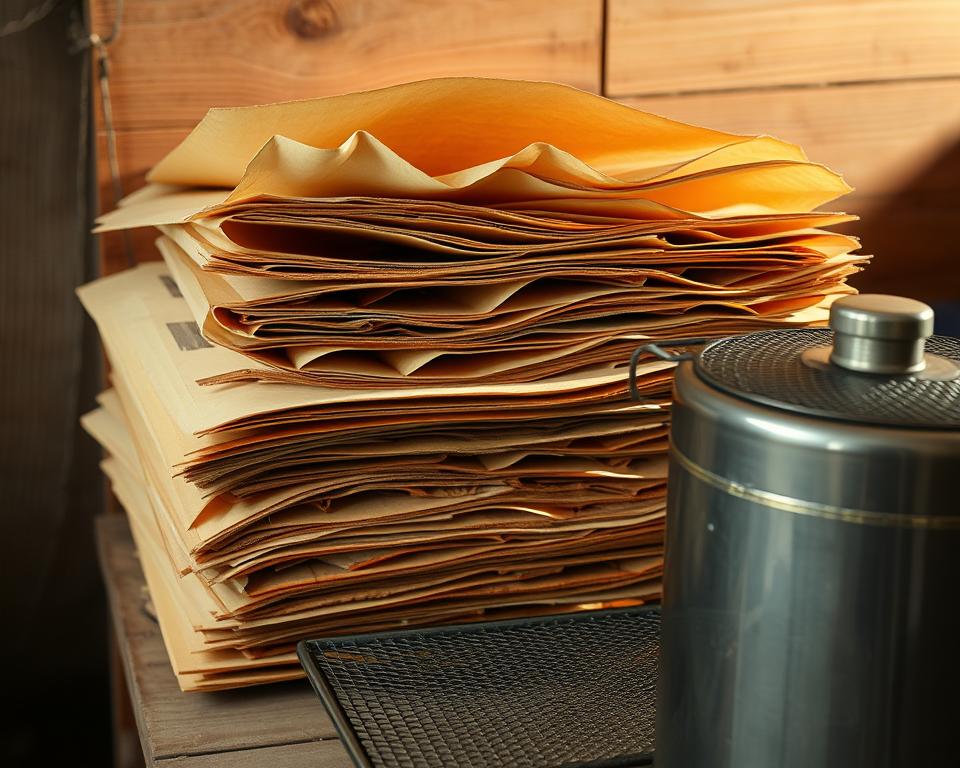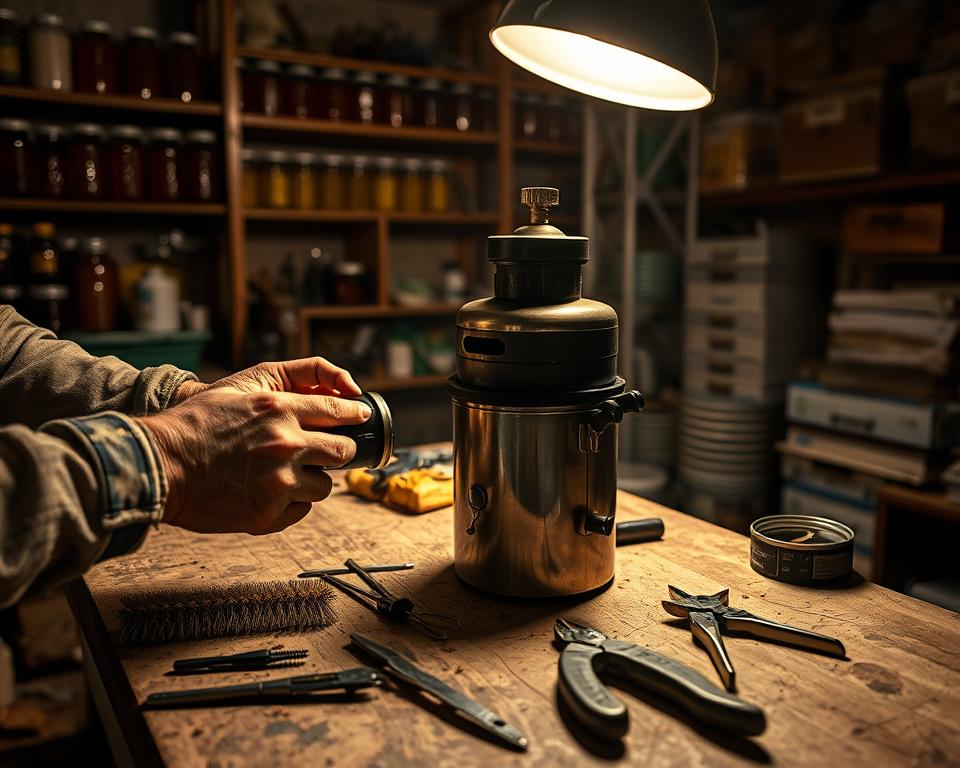As a beekeeper, you know how important it is to keep the hive calm. Did you know that the right smoker fuel can really help with that? A well-used smoker can calm the bees, making hive checks easier. In this article, I’ll explain why smoker fuel is key in beekeeping and share tips on how to prepare it.
Choosing the right smoker fuel and techniques is essential for beekeeping success. I’ll talk about the different fuels, how to get them ready, and how to keep your smoker in top shape. By the end, you’ll know how to improve your beekeeping skills.
Key Takeaways
- Understanding the role of smoker fuel in beekeeping
- Types of smoker fuels and their preparation techniques
- Best practices for maintaining your smoker
- The impact of smoke on hive behavior
- Tips for optimizing your beekeeping practices
Understanding the Role of Smokers in Beekeeping
Beekeepers use smokers to calm bees, making hive work easier. Smokers are tools that produce smoke to confuse bees. This smoke makes it safer for beekeepers to check and manage the hive.
What is a Smoker?
A smoker is a handheld device that burns fuel to make smoke. This smoke is used to calm bees in the hive. The smoke doesn’t hurt the bees; it just confuses them, making them less aggressive.
Importance of Using a Smoker
Smokers are key in beekeeping because they let beekeepers safely check the hive. They calm the bees, making hive management easier. As Buddhabee Apiary’s blog explains, smoke hides alarm pheromones, lowering bee aggression.
How Smokers Help in Beekeeping
Smokers calm bees and prevent them from getting aggressive. This makes checking the hive safer and more efficient. Keeping the smoker well-maintained is vital for it to work right when needed.
Knowing how smokers work helps beekeepers manage their hives better. The right Types of Smoker Fuel can make beekeeping tasks simpler.
Types of Smoker Fuels
Choosing the right smoker fuel is key for beekeeping. It affects both the beekeeper and the bees. There are many types of fuels, and knowing the differences is important for success.
Natural vs. Artificial Smokers
Beekeepers can pick between natural and artificial smoker fuels. Natural fuels come from organic stuff like wood and herbs. They’re good for the environment and feel more traditional. Artificial fuels, made by humans, include things like cardboard. They’re handy but might not be as eco-friendly.
When picking between natural and artificial fuels, think about a few things:
- The availability of materials
- The cost-effectiveness of the fuel
- The specific needs of your beekeeping operation
Best Fuels for Beginner Beekeepers
Choosing the right fuel can be tough for new beekeepers. Beginner beekeepers often do well with fuels that are easy to find and use. Some top picks include:
- Dried newspaper or cardboard
- Pine needles or other resinous materials
- Small twigs and dry leaves
These options are easy to get and make a gentle smoke. This smoke calms the bees without stressing them out.
Comparison of Different Fuel Types
Different fuels have different qualities that affect how well they work. Here’s a look at some common ones:
| Fuel Type | Smoke Intensity | Duration |
|---|---|---|
| Wood Chips | High | Long |
| Pine Needles | Medium | Medium |
| Cardboard | Low | Short |
Knowing these differences helps beekeepers pick the best fuel for their needs. This ensures safe and effective beekeeping.
If you’re into homemade smoker fuel recipes, try mixing dried herbs with pine needles. It’s a good and green choice. Trying out different mixes can help find the perfect fuel for beekeeping.
Common Natural Fuel Sources
Beekeepers often choose natural fuels for their smokers. These fuels are effective and easy to find. They are also good for the environment and save money.
Dried Herbs and Plants
Dried herbs and plants are a favorite for bee smoker fuel. They are easy to find and keep for a long time. Chamomile and thyme are popular because they make gentle smoke. This smoke also calms the bees.
Wood and Bark Options
Wood and bark are great natural fuels for bee smokers. Hardwoods like oak and maple burn slowly and make thick smoke. Softwoods can also be used but might not smoke as well.
Pine Needles and Other Resins
Pine needles and other resins are used in bee smokers too. They make a thick, sticky smoke that calms bees. But, they should be used carefully because they are very potent.
Here’s a comparison of the different natural fuel sources:
| Fuel Type | Smoke Characteristics | Availability |
|---|---|---|
| Dried Herbs | Gentle, calming | High |
| Wood and Bark | Thick, slow-burning | Moderate |
| Pine Needles | Thick, sticky | High |
Knowing the traits of each fuel helps beekeepers choose the best one for their needs.
Using Paper and Cardboard as Fuel
For beekeepers looking for new smoker fuels, paper and cardboard are great options. They are easy to find and don’t cost much. Let’s dive into why they’re good for beekeeping.
Advantages of Paper Products
Using paper and cardboard has many advantages. They are easy to find and often free. They also make a lot of smoke, which helps calm bees.
These materials are also good for those who want to use less wood or charcoal. It’s a green choice and can save money too.

How to Prepare Paper for Smoking
Preparing paper and cardboard is simple. Start by shredding or tearing it into smaller pieces. This makes it burn better and smoke more evenly.
Make sure the paper is dry before using it. Wet paper is hard to light and doesn’t smoke well. Dry it in a warm, dry place or a low oven.
Safety Tips for Using Paper
Using paper and cardboard is mostly safe, but be careful. Make sure the paper doesn’t have plastic or glossy stuff. These can make bad fumes when burned.
Also, watch how much smoke you make. Too much can be too much for bees and you. Aim for just enough smoke to calm them down.
| Material | Smoke Production | Ease of Use |
|---|---|---|
| Plain Paper | Moderate | Easy |
| Cardboard | High | Moderate |
| Glossy Paper | Low | Difficult |
Knowing how to use paper and cardboard as fuel can make beekeeping better. Just remember to stay safe for the best results.
Efficient Techniques for Fuel Preparation
Preparing smoker fuel in advance is key for beekeeping. It saves time and keeps you ready for beekeeping sessions.
Preparing Your Fuel in Advance
Start by picking the right materials and processing them right. Dried herbs and plants calm bees naturally. Make sure to dry them well to keep the smoke quality high.
I like using a mix of dried leaves and twigs for consistent smoke. Beginners should try different fuels to find what works best. Check out The Essential Guide to Beekeeping Smokers for more fuel options.
Storing Fuels for Long-Term Use
Storing smoker fuel right is key to keeping it effective. Store it in a dry, cool spot, out of sunlight. Use airtight containers to keep it dry and prevent moisture.
Keep fuels like paper and cardboard away from fire hazards. Labeling containers helps you quickly find what you need. For long-term storage, use plastic bins or metal containers with tight lids.
By using these fuel preparation and storage tips, beekeeping becomes more enjoyable. Being prepared is the secret to successful beekeeping.
Maintaining Your Smoker
Keeping your smoker in top shape is key for beekeeping. A well-kept smoker helps keep bees calm and the beekeeper relaxed. It’s important for a smooth beekeeping session.

How to Clean Your Smoker Properly
After each use, clean your smoker to avoid residue buildup. Start by removing fuel and ash. Use a small brush or cloth to clean the inside.
For a deeper clean, mix water with mild detergent. Avoid harsh chemicals to protect your smoker. Dry it well to prevent rust.
Regular Maintenance Tips
Maintenance is more than just cleaning. Check your smoker’s parts for wear. Look for damage on the bellows, nozzle, and other parts. Replace any damaged parts for best performance.
- Check for rust or corrosion on metal parts.
- Lubricate moving parts to keep them smooth.
- Store your smoker in a dry place to avoid moisture damage.
John Doe, a seasoned beekeeper, said, “A well-maintained smoker is not just about functionality. It’s about keeping bees and beekeepers safe.”
“The best beekeeping practices are those that prioritize the health of the bees and the equipment.”
Troubleshooting Smoker Issues
Even with regular care, problems can happen. Issues like trouble making smoke, clogging, or fuel burning unevenly can occur. Here’s how to fix them:
| Issue | Cause | Solution |
|---|---|---|
| Difficulty in producing smoke | Insufficient fuel or clogged nozzle | Check fuel level and clean the nozzle |
| Clogging | Excessive ash or debris | Clean the smoker thoroughly |
| Uneven burning of fuel | Poor quality fuel or improper packing | Use high-quality fuel and pack it correctly |
By following these tips, your smoker will stay in great condition. This will help your beekeeping activities run smoothly.
Beekeeping Techniques with Smoke
Using smoke right is key to good beekeeping. It helps you manage bees safely and well. Learning how to use smoke well is important.
How to Use Smoke Safely Around Bees
It’s important to know how smoke calms bees. Make sure the smoker doesn’t get too hot. This can harm you and the bees. Keep the smoker in good shape and know how to use it right.
As a beekeeper, “Smoke is not just a tool; it’s an art that requires patience and practice.”
“The key to successful beekeeping lies in understanding the delicate balance between smoke and bee behavior.”
Timing Your Smoke Usage
When to use smoke is very important. Use it when you’re checking the hive or doing tasks that might upset the bees. Puff smoke into the hive before opening it to calm the bees and stop them from getting aggressive.
- Use smoke 5-10 minutes before inspecting the hive to allow the bees to become calm.
- Ensure that the smoke is directed into the hive entrance and under the cover to reach all areas where bees are present.
- Monitor the bees’ reaction to smoke and adjust your usage as needed.
Observing Bee Reactions
Watching how bees react to smoke is key. If bees are too aggressive or don’t calm down with smoke, it might mean there’s a problem. Pay attention to these signs to make better beekeeping choices.
By getting better at using smoke and knowing how it affects bees, you can be a better beekeeper. Always aim to use smoke in a way that helps your bees stay healthy.
Best Practices for Smokers
As a beekeeper, I’ve learned that using a smoker effectively is key. A well-maintained smoker and the right fuel are essential. They help keep your bees calm and manageable.
Dos and Don’ts of Smoker Usage
Using a smoker right is important. Here are some key dos and don’ts:
- Do use the right type of fuel for your smoker. Best Smoker Fuel for Beekeeping is usually natural fuels like wood and dried herbs.
- Don’t over-smoke your bees. Too much smoke can stress them out and potentially harm the hive.
- Do keep your smoker clean and well-maintained. Regular cleaning prevents harmful residues.
- Don’t use fuels that produce a lot of sparks or harsh smoke. They can be harmful to both you and your bees.
Safety Guidelines for Beekeepers
Safety is always the top priority when working with smokers and bees. Here are some guidelines to follow:
| Safety Measure | Description |
|---|---|
| Wear protective clothing | Always wear a beekeeping suit, gloves, and a veil to protect yourself from stings. |
| Keep a fire extinguisher nearby | In case the smoker gets out of control, having a fire extinguisher nearby can prevent accidents. |
| Monitor smoke production | Be mindful of the amount of smoke you’re producing and adjust as necessary. |
Ethical Considerations in Smoking
Smoking is a common practice in beekeeping, but there are ethical considerations. It’s important to use smoke in a way that minimizes stress on the bees and doesn’t harm the hive.
By following best practices for smokers, you can ensure a safe and effective beekeeping experience for both you and your bees.
Enhancing Your Beekeeping Skills
Beekeeping is a skill that needs constant learning and improvement. It’s important to keep up with the best practices for healthy bees and more honey. Using a Homemade Smoker Fuel Recipe is a big help.
Joining Beekeeping Communities
Being part of beekeeping communities is great for learning. These groups share knowledge and experiences. You can learn new techniques and get advice on common problems.
Many communities have meetings, workshops, and conferences. These events are great for learning from experts and staying current with research.
Taking Beekeeping Workshops or Classes
Workshops and classes are also good for improving your skills. They cover many topics, from basics to advanced bee management.
These programs offer hands-on learning and advice from experts. You’ll learn about bee biology, hive management, and more.
| Workshop Topic | Description | Benefit |
|---|---|---|
| Bee Biology | Understanding the basics of bee behavior and biology | Improved hive management |
| Hive Management | Techniques for maintaining healthy bee colonies | Better honey production |
| Pest Control | Methods for controlling pests and diseases in bee colonies | Healthier bees |
By joining communities and taking classes, beekeepers can get better. Whether you’re new or experienced, there’s always more to learn. And remember, a good Homemade Smoker Fuel Recipe is just the start.
The Impact of Smoke on Hive Behavior
Understanding how smoke affects hive behavior is key for good beekeeping. As a beekeeper, I’ve seen how smoke calms bees, making hive checks easier.
Smoke in the hive makes bees think there’s danger, like a forest fire. They eat honey, getting ready to leave. This makes them less likely to sting, helping beekeepers work safely.
Understanding Bee Responses to Smoke
Bees see smoke as a warning of danger. They eat honey, getting ready to leave. This makes them calmer, reducing the chance of getting stung.
The right Bee Smoker Fuel is important. It makes the smoke just right, keeping bees calm.
Effects on Honey Production
Smoke helps calm bees but also affects honey production. Stressed bees eat more honey, which can lower yields.
But, with the right Bee Smoker Fuel, beekeepers can keep honey production good. They can also keep beekeeping safe and efficient.
Conclusion: Mastering Smoker Fuel and Techniques
Effective beekeeping depends a lot on mastering smoker fuel and techniques. Knowing how smokers work and the different fuels available helps beekeepers manage their bees better. This improves their beekeeping experience.
Key Takeaways
In this article, we looked at the role of smokers in beekeeping. We also covered different smoker fuels and how to prepare them efficiently. These tips help beekeepers create a more sustainable and peaceful beekeeping practice.
Sustainable Beekeeping
As beekeepers, adopting sustainable practices is key. It benefits our bees and the environment. Choosing the right smoker fuel and techniques reduces our impact and supports healthy bee colonies.
I suggest trying natural and eco-friendly smoker fuels like dried herbs and plants. This can boost your beekeeping skills.
